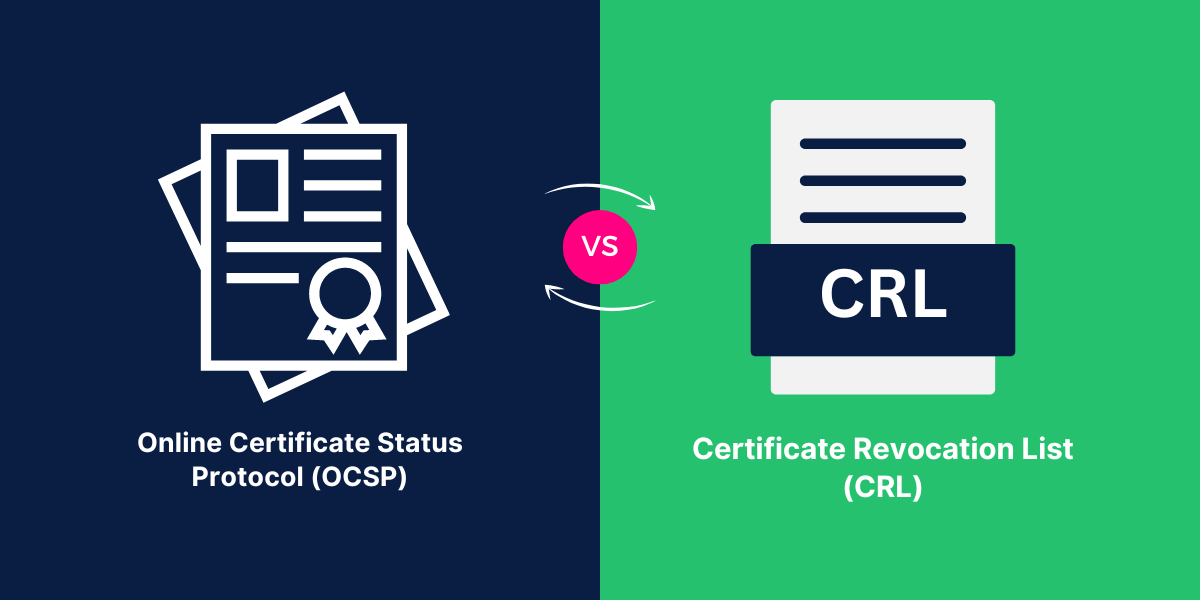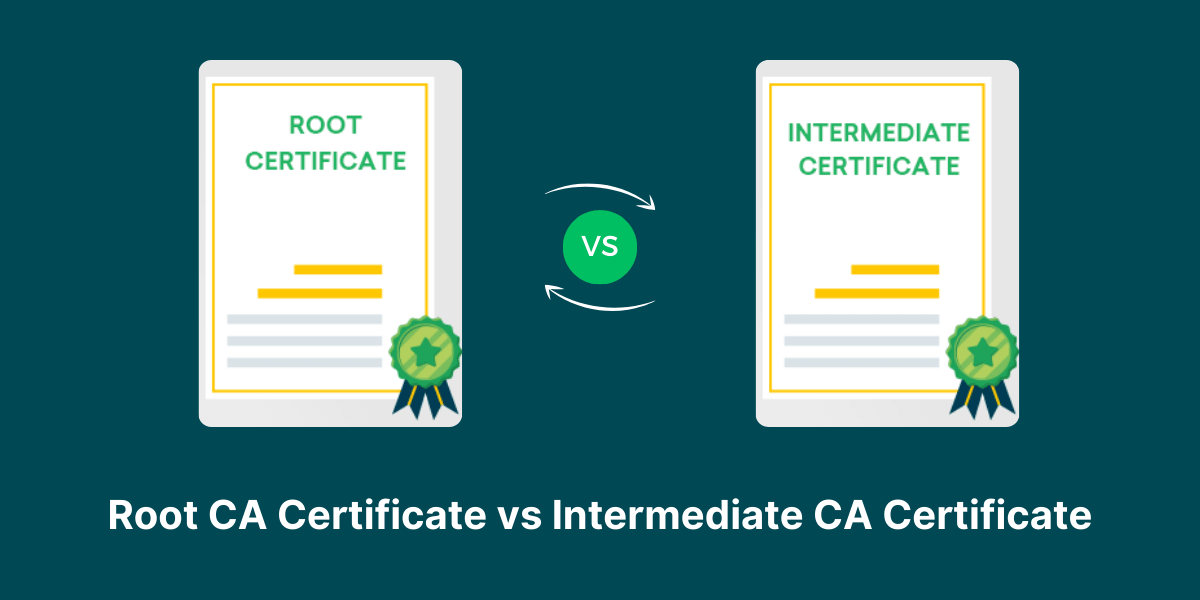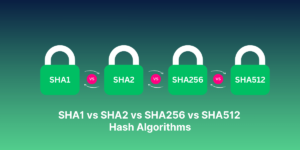What’s the Difference Between OCSP vs CRL
The management of digital certificates is a crucial aspect of cybersecurity, and the choice between OCSP (Online Certificate Status Protocol) and CRL (Certificate Revocation List) is a key consideration. OCSP vs CRL is a topic that has been widely discussed in the industry, as each approach offers distinct advantages and trade-offs.
Understanding the nuances of these two methods for verifying the validity of digital certificates can help organizations make an informed decision that aligns with their specific security requirements and operational needs.
Exploring the differences between OCSP and CRL, as well as their respective strengths and limitations, is essential for developing a robust and efficient certificate management strategy.
Key Takeaways
- OCSP (Online Certificate Status Protocol) and CRL (Certificate Revocation List) are both used to check the validity of digital certificates.
- OCSP is an online protocol that provides real-time certificate status checking, while CRL is a periodically updated list of revoked certificates published by the CA.
- OCSP offers improved validation speed and flexibility but can have scalability issues for large CAs. CRL avoids real-time network connections but provides only periodic updates.
- Most major browsers and applications support both OCSP and CRL, so using both provides failover if one method is unavailable.
- OCSP stapling allows OCSP validation to be cached by web servers, avoiding the latency of external OCSP checks.
- Both OCSP and CRL have issues related to privacy and potential spoofing/denial-of-service attacks. Proper CA practices are required to mitigate risks.
Head to Head Comparison Between OCSP vs CRL
|
Feature |
OCSP |
CRL |
|
Validation Time |
Real-time |
Periodic based on update frequency |
|
Network Dependency |
Requires online checking |
Can validate from cached CRLs offline |
|
Latency Overhead |
Each request has some latency for network round trip |
Local CRL check has minimal latency |
|
Scalability |
Can have scalability challenges on CA side |
Distributed CRL caches avoid centralized load |
|
Revocation Propagation Delay |
Revocations blocked immediately |
Latency until next CRL publication |
|
Implementation Complexity |
Responder deployment for CA |
Significant CRL management overhead |
|
Bandwidth Overhead |
Very lightweight requests |
Can have bloated downloads for large CRLs |
|
Security Considerations |
Spoofing, DoS attacks, privacy leaks |
Spoofing CRLs, ensuring authenticity |
|
Privacy |
OCSP leaks info to CA on each request |
CRLs avoid active info leakage |
|
Browser/Client Support |
Supported by all major browsers |
Also universal standard support |
|
Failover Capabilities |
CRL acts as fallback if OCSP fails |
OCSP secondary mechanism if CRL lapses |
How Does OCSP Works
OCSP is an internet protocol defined in RFC 6960 that provides real-time status checking of digital certificates. With OCSP, the certificate validity is checked by querying the OCSP responder server operated by the issuing CA or a trusted delegate.
When an application needs to check a certificate status, it calls the OCSP responder and passes the certificate in question. The OCSP responder will check against its internal database and then return a signed response signifying that the certificate is either good, revoked, or unknown. The querying client can then immediately determine the revocation status without needing to download full CRLs.
Key advantages of OCSP
- Real-time validity checking: OCSP allows up-to-the-second verification, unlike CRLs, which may only be updated periodically. This allows truly revoked certificates to be blocked immediately.
- Flexible architecture: The OCSP responder can be separately scaled to handle high-traffic loads. CAs can delegate responder handling to third parties.
- Lightweight operation: OCSP request packets are small, and no full CRLs need to be downloaded. OCSP imposes lower overhead.
- Useful diagnostics: The OCSP responder can provide reasons for revocation and detailed status beyond “good” or “revoked.”
- No fixed update periods: New OCSP requests can be made at any time rather than waiting for the next CRL publication.
Notable Downsides of OCSP
- Online requirement: Real-time OCSP checks require an active network connection between the client and responder. Offline or air-gapped operation is generally not feasible.
- Potential latency overhead: The round-trip time to check each certificate creates latency and performance concerns compared to locally cached CRLs.
- Scalability challenges: The OCSP responder must handle traffic spikes and denial-of-service attacks. OCSP stapling helps partially mitigate this concern.
- Privacy issues: OCSP requests can be used to track users and server activities since each check queries the CA.
How Does CRLs Work
A Certificate Revocation List (CRL) is a digitally signed list of revoked certificates published periodically by a Certificate Authority (CA). It was originally defined in RFC 5280 as a format for CAs to distribute revoked certificate information to relying parties.
Here’s how CRL-based revocation checking typically works:
- The CA generates and digitally signs a CRL containing serial numbers of all revoked certificates over a given period. This CRL is posted at a publicly accessible URL.
- Applications, servers, and clients download the latest CRL from the CA at regular intervals (e.g., every few hours). The CRL is cached locally.
- When validating a certificate, the application checks its serial number against the cached CRL. If the certificate is listed in the CRL, it is considered revoked.
- Periodically, the application will refresh its CRL cache by downloading the newest CRL from the CA.
Key advantages of CRLs
- Simple decentralized distribution: CRLs can be easily cached and distributed without relying on a centralized revocation server.
- Limit network dependencies: Certificate validity can be determined offline based on the cached CRL.
- Handle high volumes more easily: CRLs avoid a direct query per certificate checked and reduce the load on the CA.
- Auditability via CRL logs: Having the full CRL published periodically provides audit visibility.
Notable Downsides of CRLs
- Latency in revocation propagation: Newly revoked certificates will still show as valid until the next CRL is published, which may be up to 24 hours.
- Bloated downloads: CRLs tend to swell in size as more certificates are revoked over time, making downloading and distributing large CRLs inefficient.
- CRL management overhead: Maintaining up-to-date CRLs across systems involves non-trivial overhead for administrators.
- Only periodic updates: CRLs are fixed snapshots in time and may be outdated until the next publication. OCSP provides real-time checking.
OCSP Stapling
OCSP stapling aims to combine the benefits of OCSP and CRLs by having the certificate holder cache OCSP responses. With OCSP stapling, the server hosting a certificate will periodically query the OCSP responder and obtain an OCSP verification response. This “pre-fetched” OCSP response is then included (stapled) during the initial TLS handshake:
- The client connects to the server and initiates a TLS/SSL handshake.
- The server includes the cached OCSP verification status for its certificate in the TLS handshake.
- The client validates that the stapled OCSP response is signed properly. If so, the certificate is considered verified without needing an external OCSP lookup.
OCSP stapling improves efficiency and privacy:
- Avoid external lookups: The client can use the stapled OCSP response without querying the CA responder directly, which saves latency.
- Improved privacy: The CA isn’t directly queried on every client connection, reducing tracking of client activities.
- Shift load to server: The certificate holder, rather than the clients, handles the overhead of caching and refreshing OCSP responses.
On the other hand, OCSP stapling requires compatible web server software and properly configured host certificates. Stapled responses that expire can still fall back to external OCSP checking. When implemented correctly, OCSP stapling combines the scalability of CRLs with the real-time validity of OCSP.
Support in Major Browsers
Modern web browsers and applications support both OCSP and CRLs for handling certificate revocation checking:
- Google Chrome enables both OCSP and CRL by default but prefers OCSP. OCSP stapling is also supported.
- Mozilla Firefox has OCSP enabled by default but also supports CRLs. Firefox does OCSP checks in parallel with initial TLS handshakes.
- Apple Safari favors OCSP but will use downloaded CRLs if OCSP servers cannot be reached. Safari also supports OCSP stapling.
- Microsoft Edge uses both OCSP and CRLs, and it prefers OCSP. Both OCSP and CRL checking are enabled by default.
- Java relies primarily on OCSP for revocation checking but also supports downloaded CRLs as a fallback mechanism.
- Windows, macOS, iOS, Android, and most Linux distributions include OCSP and CRL support in their native crypto libraries, which are used by apps.
Given this nearly universal support, using both OCSP and CRL covers the broadest range of client software. If OCSP is unavailable due to network issues or server problems, CRLs can provide a backup method for validation. Running both also allows auditing CRL records alongside real-time OCSP logs.
Security Considerations
While OCSP and CRLs address the critical issue of certificate revocation, both come with security and privacy considerations that must be carefully addressed:
- Denial of service: An attacker may overwhelm OCSP responders with spoofed requests, denying service to legitimate users. Caching and request rate limiting help mitigate such threats.
- Privacy issues: OCSP requests inherently reveal information to the CA about client activities and the servers they interact with. CRLs avoid this active querying. Proper OCSP implementation should minimize data collection.
- Spoofing revoked certificates: If OCSP security is compromised, an attacker could spoof responses to make revoked certificates appear valid. Strict response signing requirements help prevent spoofing.
- CRL validity: Downloaded CRLs must be authenticated and checked for validity. A spoofed or tampered CRL would allow revoked certificates.
- Revoked CA certificates: If a CA’s certificate is revoked, validating OCSP responses and CRLs signed by that CA becomes problematic. An independent validation path may be needed.
- Shared infrastructure: If the OCSP responder shares infrastructure with the CA website or other services, attacks against those services could also compromise the OCSP server. Proper isolation is required.
Best Practices for Usage
Based on the pros, cons, and security considerations for OCSP and CRLs, these best practices should guide real-world usage:
- Use OCSP as the primary method where possible for its real-time checking. Make OCSP the default for browsers and clients.
- Maintain CRLs as a secondary mechanism if OCSP is unavailable. This provides failover and audit visibility.
- Disable OCSP only if network connectivity is unavailable. For air-gapped systems, CRLs may be the only option.
- Implement OCSP stapling on websites to optimize privacy and performance. Stapled responses reduce direct CA queries.
- Use short CRL expiration periods like 24 hours to limit windows of latency for revoked certificates.
- Evaluate caching, CDNs, and load balancing for OCSP servers to prevent responder overload.
- Monitor CA infrastructure 24/7 and implement alerting to detect OCSP/CRL failures or anomalies.
- Isolate the OCSP responder from other CA services to limit the attack surface. Limit data exposure.
Final Thoughts
OCSP and CRLs both verify the critical certificate revocation status for all secure websites, devices, and applications. While OCSP’s real-time checking has made it the preferred method, maintaining CRLs as a fallback ensures maximum coverage and reliability.
By understanding the technical and security differences between OCSP and CRL implementations, organizations can craft an optimal revocation strategy that combines real-time status, scalability, and availability while minimizing risks and vulnerabilities. Carefully implementing OCSP and CRL together addresses the weaknesses of each approach.
With digital certificates now a cornerstone of authentication and encryption across the internet and within enterprises, having robust visibility into certificate validity through OCSP and CRLs provides the foundation for secure and resilient business applications. Managing certificate lifecycles remains essential to limiting the impact of inevitable certificate compromises in the future.
Frequently Asked Questions
Is OCSP better than CRL?
OCSP is generally better than CRL because it provides real-time certificate status checking. However, CRLs are still useful as a fallback when OCSP is unavailable.
Does OCSP stapling improve privacy?
Yes, OCSP stapling avoids exposing client activities to the CA on each request, improving privacy.
What are the security risks of OCSP?
Risks include denial-of-service attacks, privacy violations, and spoofing responses to hide revoked certificates. Proper implementation can mitigate these risks.
How often are CRLs published?
CRLs are typically published frequently: every few hours up to a maximum of 24 hours: to limit delays in updating revoked certificates.
Does OCSP have scalability issues?
Yes, OCSP responders can face scalability challenges under high traffic loads. Caching and distributing the load are best practices for handling scale.
Can CRLs be used offline?
Yes, CRLs allow certificate checking without any network connectivity since the list is cached locally on devices.

Priya Mervana
 Verified Web Security Experts
Verified Web Security Experts
Priya Mervana is working at SSLInsights.com as a web security expert with over 10 years of experience writing about encryption, SSL certificates, and online privacy. She aims to make complex security topics easily understandable for everyday internet users.



